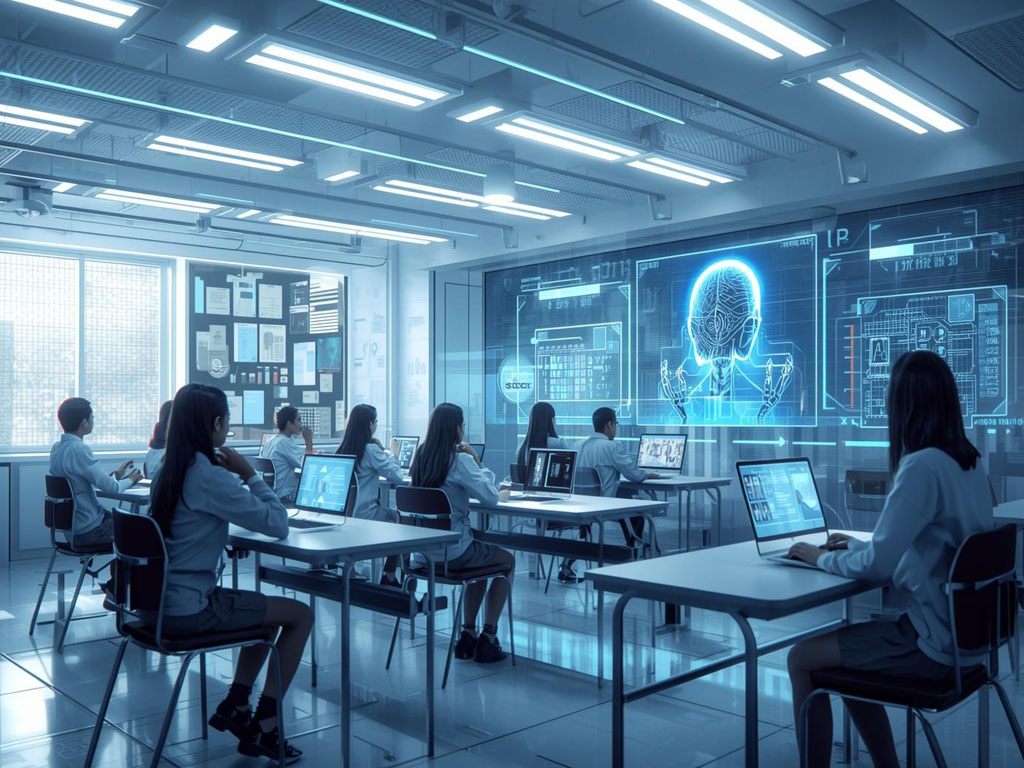Artificial Intelligence (AI) has ceased to be a futuristic dream — it is already changing the way we learn, teach, and assess knowledge today. Education is becoming more personalized, adaptive, and flexible, while AI technologies help make learning more efficient, engaging, and accessible to everyone.
AI and education go hand in hand. According to the analytical platform HolonIQ, the global market for educational technologies using AI (EdTech AI) is growing by more than 25% each year. More and more schools, universities, and learning platforms are integrating machine learning algorithms, voice assistants, and adaptive systems that help not only acquire knowledge but also understand the student as an individual.
- How Artificial Intelligence Is Changing Education
- What Artificial Intelligence Technologies Mean in Education
- Key Artificial Intelligence Technologies That Increase Learning Efficiency
- How AI Helps Teachers and Educators
- What Are Advantages of Using Artificial Intelligence Technologies in Education
- What Are Possible Risks and Challenges of Using AI in Education
- What is The Future of Education with AI Technologies
- Conclusion: How Artificial Intelligence Makes Learning More Effective
- FAQ: AI and Education
- How to Integrate AI into the Learning Process
How Artificial Intelligence Is Changing Education
AI has already become a powerful tool in modern learning. Its main advantage lies in its ability to analyze large amounts of data, identify patterns, and adapt materials to each student.
AI helps to:
- individualize the learning approach;
- automate assessment;
- improve feedback between teacher and student;
- create “smart” digital tutors.
Using artificial intelligence in education is not about replacing the teacher but expanding their capabilities. The machine takes over routine tasks, while the human focuses on creativity, mentorship, and emotional support.
What Artificial Intelligence Technologies Mean in Education
“Artificial intelligence technologies” refer to software systems capable of learning, analyzing information, and making decisions similar to a human.
In education, AI manifests itself through:
- machine learning (Machine Learning) — algorithms that study student behavior and predict their results;
- natural language processing (Natural Language Processing, NLP) — understanding texts, spoken language, writing, and grading assignments;
- computer vision (Computer Vision) — analyzing images, emotions, and gestures during online learning;
- recommender systems (Recommender Systems) — selecting educational content according to the user’s level and interests.
These technologies allow the creation of a dynamic learning environment that responds to each student’s needs in real time.
Key Artificial Intelligence Technologies That Increase Learning Efficiency
Machine Learning — Smart Progress Analytics
Machine learning allows systems to identify patterns in student behavior, analyze tests, task completion speed, mistakes, and use that data to create individual recommendations.
Example:
Century Tech — a British AI platform that adapts learning materials to each student’s level, tracks progress, and predicts when fatigue or loss of concentration might occur.
Result — the student receives exactly those tasks that help them learn more effectively without overloading the brain.
Natural Language Processing (NLP) — Interaction Without Barriers
NLP technologies enable computers to understand human language, answer questions, analyze texts, and even write essays.
Examples:
- ChatGPT helps students explain complex topics, practice critical thinking, and generate ideas for projects.
- Grammarly uses AI to analyze writing, correct grammatical errors, and teach clearer expression of thoughts.
Such tools become personal language assistants that develop communication skills and make learning more interactive.
Computer Vision — “Seeing” Technology in Learning
AI can analyze webcam video to track student concentration, detect emotions, engagement levels, and fatigue.
Example:
ScribeSense — a system that automatically checks handwritten assignments, recognizes handwriting, and even interprets notebook drawings.
This reduces teachers’ workload and increases grading accuracy.
Adaptive Learning Systems — Learning at Your Own Pace
One of AI’s main advantages in education is adaptability. The system adjusts to the user’s pace, knowledge level, and even emotional state.
Examples:
- Duolingo uses AI for language learning: the app analyzes user errors, revisits difficult topics, and gradually increases the complexity of material.
- Coursera adapts courses to student needs — emphasizing topics the user interacts with most often.
Such tools help make learning more personalized and motivating.
Intelligent Recommender Systems
AI systems analyze the user’s learning history and suggest the most useful courses, books, or videos.
Example:
Khan Academy uses artificial intelligence to create individual learning paths — from basic to advanced levels, depending on student progress.
These systems resemble Netflix for education — they know what interests you and help you stay motivated.
How AI Helps Teachers and Educators
Artificial intelligence does not replace the teacher — it enhances their capabilities.
Automation of Routine Processes
AI can automatically grade tests, track student progress, and generate reports. This saves dozens of hours each month that teachers can dedicate to meaningful interaction with students.
Personalized Approach
AI helps determine which learning style suits each student, what topics cause difficulties, and suggests ways to improve.
Content Creation
Teachers can use AI assistants to quickly create educational materials, interactive quizzes, presentations, or lesson plans.
What Are Advantages of Using Artificial Intelligence Technologies in Education
- Personalization — learning adapts to each individual’s needs.
- Flexibility — the ability to study anytime and anywhere.
- Efficiency — AI optimizes programs, removes unnecessary information, and boosts motivation.
- Inclusivity — support for students with special needs (voice recognition, subtitles, audio instructions).
- Analytics — teachers can see the real picture of classroom knowledge.
What Are Possible Risks and Challenges of Using AI in Education
No technology is without risks. The use of AI in education comes with several important challenges:
- Data privacy: algorithms collect large volumes of personal information.
- Dependence on technology: students may lose independent thinking skills.
- Algorithmic bias: if the system is trained on unbalanced data, it may evaluate unfairly.
- Ethical issues: can a machine truly understand human values?
That’s why it’s essential for humans to remain at the center of the educational process, with artificial intelligence serving as an assistant.
What is The Future of Education with AI Technologies
In the coming years, education will become even more interactive, flexible, and intelligent.
AI will be able to create virtual teachers who know your level of knowledge and even your mood.
Future development directions:
- immersive learning through VR/AR (virtual and augmented reality);
- AI mentors with human-like voices;
- lifelong learning ecosystems where people learn continuously.
Conclusion: How Artificial Intelligence Makes Learning More Effective
AI technologies have already proven they can transform education into a dynamic, flexible, and motivating process. They help people learn faster, smarter, and deeper — but most importantly, more consciously.
AI is not just a set of algorithms. It is a tool that enables every student to unlock their potential, regardless of age, ability, or country. True learning efficiency happens when technology and humanity go hand in hand.
FAQ: AI and Education
AI helps personalize learning by adapting materials to each student’s level and pace. With data analysis algorithms, teachers can assess progress more accurately, while students receive more effective support.
Artificial intelligence is used in student-assistance chatbots, automated grading systems, virtual tutors, adaptive learning platforms, and educational data analytics tools.
AI does not replace teachers — it enhances their work. The technology automates routine tasks like test grading, report generation, and content selection, allowing educators to focus on creativity and pedagogy.
Students benefit from a personalized approach, instant feedback, and access to learning resources anytime. AI algorithms help identify weak areas and suggest topics to focus on for better performance.
Key risks include algorithmic bias, insufficient personal data protection, and overreliance on technology. Ethical standards and human oversight are essential for responsible use of AI in education.
How to Integrate AI into the Learning Process
Time needed: 1 hour
A step-by-step guide to implement AI in education: goal-setting, tool selection, policy, pilot launch, and measurement:
- Define goals and use cases
Clarify objectives: personalization, automated grading, tutoring, progress analytics. Select pilot courses.
- Select the right AI tools
Map goals to solutions: adaptive platforms, chatbots, test generators, teacher assistants.
- Set policy and ethics
Define rules for academic integrity, personal data protection, and acceptable AI use for students and faculty.
- Run a pilot and train instructors
Provide short training, create instructions and AI-enhanced assignment templates. Launch a pilot in 1–2 cohorts.
- Measure outcomes and scale
Track engagement, feedback speed, and test results. Scale the practices that work best.



